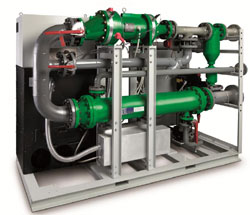The remote city of Kotzebue, Alaska, north of the Arctic Circle, depends on just one shipment a year of diesel fuel. It arrives by vessel during the summer when the ocean is free of ice.
That one shipment supplies the city’s 3200 residents with electricity and heat, which beyond the logistical challenges of getting it there, is quite expensive.
General Electric (GE) has joined with the electrical coop, Kotzebue Electric Association, to increase energy efficiency and extend the fuel supply by using waste heat.
GE’s Clean Cycle heat-to-power generator captures exhaust heat from diesel engines to produce electricity for the local grid. It will enable the city to save 46,000 gallons of diesel fuel a year.

Surplus heat will also supplement the city’s jacket water system to heat the city’s potable water, rather than using oil-fueled boilers.
Small-scale waste heat recovery can make a big difference for utilities around the world that rely on diesel.
GE’s Clean Cycle technology generates electricity from heat in a process called the Organic Rankine Cycle, which produces no additional emissions. At the core of the Clean Cycle generator is the integrated power module, a turbine generator that runs without any external seals, gearboxes, gearing oils or lubricants, which allows for minimal servicing.
The technology captures heat from a variety of applications, including various engine types, biomass boilers and turbines.
The electrical coop is also investing in solar hot water and wind.
On a much bigger scale, waste heat is powering telecommunications company Telus’s headquarters in Vancouver. Waste heat generated by its adjacent data center, and the new office tower’s cooling system, will provide heat, hot water and cooling for the buildings.
